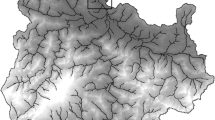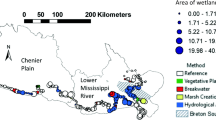Abstract
Wetland restoration is largely a developing science and engineering enterprise. Analyses of results are too few and constrained to observations over a few years. We report here on the effectiveness of one restoration technique used sparsely in coastal Louisiana for several decades. Canals have been dredged in coastal Louisiana wetlands since 1938 for oil and gas exploration and extraction. These canals are typically dredged to 2.5 m depth and are 20 to 40 m wide. Canal lengths vary from 100 m to several 1000s m in the case of outer continental shelf pipeline canals that cross the wetlands.
Today, thousands of miles of canals crisscross these wetlands. Studies have linked dredged canals to a number of undesirable effects on the wetland environment including alterations in salinity, flooding and drainage patterns, direct loss of marsh by convention to open water, and increases in marsh erosion rates. These effects have led state and federal agencies charged with managing the wetland resource to look for methods of mitigating canal impacts. One possible method of managing spoil banks after the abandonment of a drilling site is to return spoil material from the spoil banks to the canal with the hope that marsh vegetation will be reestablished on the old spoil banks and in the canal. The movement of former spoil bank material back into the canal is referred to as ‘backfilling’.
The purpose of this study was to (1) examine how backfilled canals changed over 10 years, (2) examine factors influencing success with multiple regression statistical models, and, (3) compare costs of backfilling with other Louisiana marsh restoartion projects. We examined the sites to document and interpret changes occurring since 1983/4 and to statistically model the combined data derived from these new and previous analyses. Specifically, we wanted to determine the recovery rates of vegetation, water depth, and soils in backfilled canals, ‘restored’ spoil banks, and in nearby marshes, and to quantify the influence of plugging canals on these rates.
The major factors determining backfilling restoration success are the depth of the canal, soil type, canal dimensions, locale, dredge operator skill, and permitting conditions. Plugging the canal has no apparent effect on water depth or vegetation cover, with the exception that submerged aquatic vegetation may be more frequently observed behind backfilled canals with plugs than in backfilled canals without plugs. Canal age, soil organic matter content, and whether restoration was done as mitigation on-site or off-site were the most important predictors of final canal depth. Canal length and percentage of spoil returned (+) had the greatest effect on the restoration of vegetation cover. Backfilled canals were shallower if they were older, in soils lower in organic matter, and backfilled off-site. Backfilling the canal restores wetlands at a cost of $1,200 to $3,400/ha, which compares very favorably with planned restoration projects in south Louisiana.
Similar content being viewed by others
References
Bozeman, E.L. and Dean, J.M. 1980. The abundance of estuarine larval and juvenile fish in a South Carolina creek. Estuaries 3: 89–97.
Chabreck, R.H. 1979. Winter habitat of dabbling ducks — physical, chemical and biological aspects. pp. 133–142. In: Waterfowl and Wetlands — An Integrated Review. Edited by T.A. Bookhout. The Wildlife Society.
Cahoon, D.R. and Groat, C.G. editors 1990. A study of marsh management practice in coastal Louisiana. Final report 0001-30410 to the Minerals Management Service, New Orleans, La. OCS Study/ MMS 90-0075.
Cahoon, D.R. and Turner, R.E. 1989. Accretion and canal impacts in a rapidly subsiding wetland. 11. Feldspar marker horizon technique. Estuaries 12: 260–268.
Cowan, Jr., J.H., Turner, R.E. and Cahoon, D.R. 1988. Marsh management plans in practice: do they work in coastal Louisiana? Environmental Management 12: 37–53.
Craig, N.J., Turner, R.E. and Day, Jr., J.W. 1979. Land loss in coastal Louisiana (U.S.A.). Environmental Management 3: 133–144.
Fredrickson, L.H. and Drobney, R.D. 1979. Habitat utilization by postbreeding waterfowl. pp. 119–131. In: Waterfowl and Wetlands—An Integrated Review. Edited by T.A. Bookhout. The Wildlife Society.
Gagliano, S.M., Meyer-Arendt, K.J. and Wicker, K.M. 1981. Land loss in the Mississippi River deltaic plain. Transactions Gulf Coast Association Geological Society 31: 295–300.
Neill, C. and Turner, R.E. 1985. An evaluation of backfilling canals as a means of mitigating the environmental impact of canals in south Louisiana: Atlas of backfilled canals. Report to the Coastal Management Division, Louisiana Department of Natural Resources, Baton Rouge, Louisiana, 192 pp.
Neill, C. and Turner, R.E. 1987a. Backfilling canals to mitigate wetland dredging in Louisiana coastal marshes. Environmental Management 11: 823–836.
Neill, C. and Turner, R.E. 1987b. Comparisons offish communities in open and plugged backfilled canals in Louisiana coastal marshes. N. Am. J. Fish. Managmt. 7: 57–62.
Ott, L. 1977. An Introduction to Statistical Methods and Data Analysis. Duxbury Press, North Scituate, Massachusetts.
Perry, G.W. 1976. Standing crops of fishes of an estuarine area in southwest Louisiana. Proc. 30th Annual Southeastern Fish and Wildlife Agencies 30: 71–81.
Reed, D.J. 1989. Patterns of sediment deposition in subsiding coastal marshes, Terrebonne Bay, Louisiana: The role of winter storms. Estuaries 12: 222–227.
Sasser, C.S. 1977. Distribution of vegetation in Louisiana coastal marshes as response to tidal flooding. M.S. Thesis, Louisiana State University, Baton Rouge. 40 pp.
Sikora, W.B. and Sikora, J.P. 1984. Benthos. In: Evaluation of Back-filling Canals as a Means of Mitigating the Environment Impact of Canals. Edited by R.E. Turner, I.A. Mendelssohn, R. Costanza, K.L. McKee, C. Neill, J.P. Sikora, W.B. Sikora and E. Swenson. Final Rept. Coastal Management Section, Louisiana Department Natural Resources. Dec. 1984.
Snedecor, G.W. and Cochran, W.G. 1967. Statistical methods. Iowa State Univ. Press, Ames. Sixth Edition. 593 pp.
Swenson, E.M. and Turner, R.E. 1987. Spoil banks: Effects on a coastal marsh water level regime. Estuarine, Coastal and Shelf Science 24:599–609.
Turner, R.E., Medelssohn, I.A., McKee, K.L., Costanza, R., Neill, C., Sikora, J.P., Sikora, W.B. and Swenson, E. 1988. Backfilling Canals in coastal Louisiana. Proc. National Wetlands Symposium: Mitigation of Impacts and Losses. Assoc. State Wetland Managers, Inc., New Orleans, Oct. 1986, pp. 135–141.
Turner, R.E. and Cahoon, D.R. (editors). 1987. Causes of Wetland Loss in the Coastal Central Gulf of Mexico. Vo. Executive Summary; Vol. 2: Technical Narrative. Vol. 3: Appendices. Final report submitted to Minerals Management Service, New Orleans, LA. Contract No. 14-12-001-30252. OCS Study/MMS 87-0119. 536 pp.
Turner, R.E., Swenson, E.M. and Lee, J.M. 1994. A rationale for coastal wetland restoration through spoil bank management in Louisiana. Environmental Management 18: 271–282.
Weinstein, M.P. 1979. Shallow marsh habitats as primary nurseries for fish and shellfish, Cape Fear River, North Carolina. Fish. Bull. 77: 339–357.
Author information
Authors and Affiliations
Additional information
Corresponding Editor: Anonumous
Rights and permissions
About this article
Cite this article
Turner, R.E., Lee, J.M. & Neill, C. Backfilling canals to restore wetlands: empirical results in coastal Louisiana. Wetlands Ecol Manage 3, 63–78 (1994). https://doi.org/10.1007/BF00177297
Received:
Accepted:
Issue Date:
DOI: https://doi.org/10.1007/BF00177297




